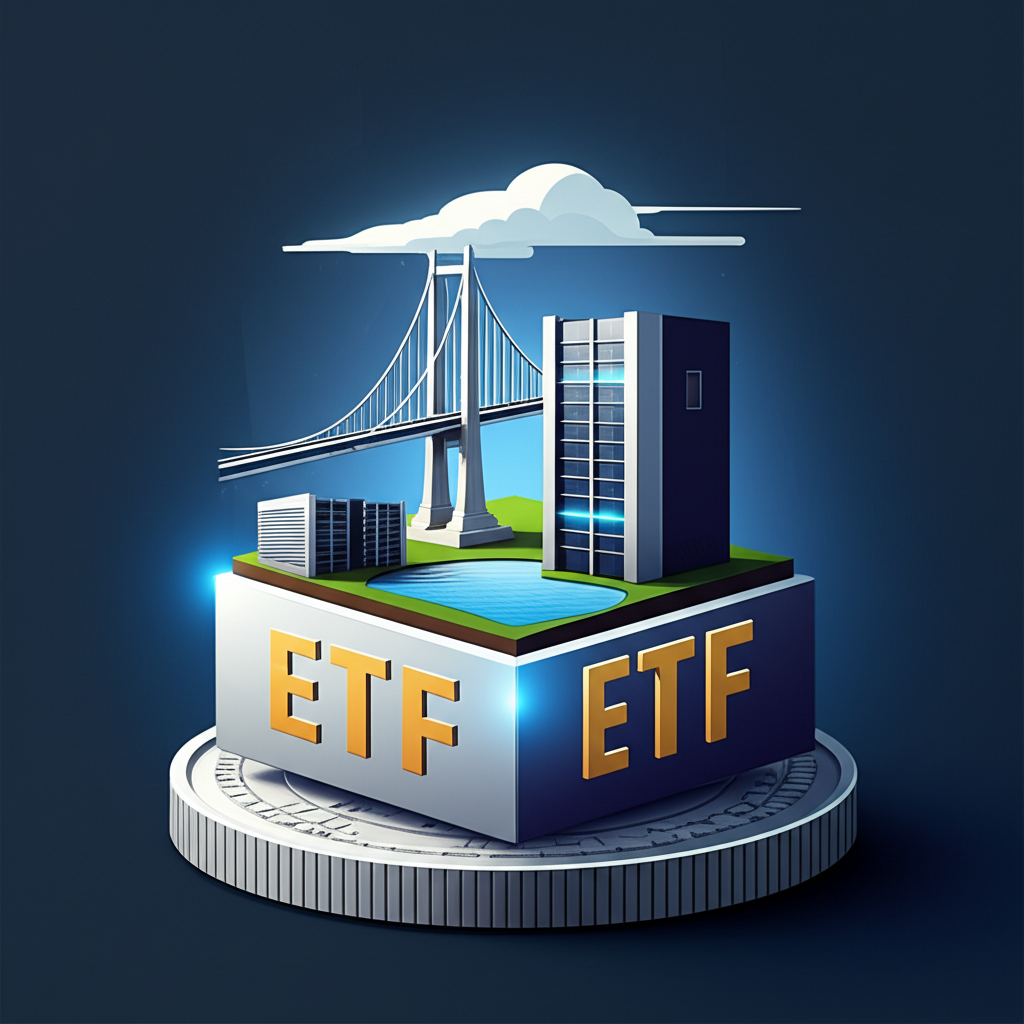What Are Infrastructure ETFs and How Do They Work?

Infrastructure forms the silent foundation of modern life—supporting everything from morning commutes to seamless online streaming. Behind this vast network lie long-term assets like highways, power grids, and data centers, many of which are owned and operated by publicly traded companies. Infrastructure Exchange Traded Funds (ETFs) offer investors a streamlined way to gain exposure to this critical sector without having to pick individual stocks. These funds pool capital to invest in a diversified portfolio of infrastructure-related equities, spanning transportation, utilities, digital networks, and more.
Unlike direct ownership of physical infrastructure, which is typically restricted to institutional investors or governments, Infrastructure ETFs bring accessibility to retail investors. When you purchase shares in an Infrastructure ETF, you’re buying into a fund that holds a basket of companies involved in building, operating, or maintaining essential infrastructure. These funds trade on major stock exchanges just like individual stocks, allowing for real-time pricing, intraday trading, and strong liquidity. Most follow a passive strategy by tracking a benchmark index—such as the S&P Global Infrastructure Index—while others are actively managed, with portfolio managers selecting holdings they believe will outperform the market. This blend of diversification, transparency, and ease of access makes Infrastructure ETFs an appealing option for investors seeking stable, long-term growth.
Why Invest in Infrastructure ETFs? Key Benefits for Your Portfolio

Investing in Infrastructure ETFs goes beyond simply chasing returns—it’s about building resilience into your portfolio. The nature of infrastructure assets—essential, long-lived, and often protected by regulatory frameworks—translates into unique financial advantages that stand out across market cycles.
Inflation Hedge and Stability
One of the most compelling reasons to consider infrastructure investments is their historical ability to weather inflation. Many infrastructure operators, particularly in utilities and transportation, have pricing models that automatically adjust with inflation. For example, toll road operators may increase fees annually based on the Consumer Price Index, while regulated utilities often receive rate hikes approved by public utility commissions to maintain return on capital. This built-in pricing power helps preserve purchasing power over time. According to research from S&P Dow Jones Indices, infrastructure equities have shown a positive correlation with inflation, making them a strategic asset during periods of rising prices. In volatile economic climates, these stable revenue streams offer a defensive buffer, contributing to smoother overall portfolio performance.
Diversification and Reduced Volatility
Infrastructure ETFs typically exhibit low correlation with traditional stock and bond markets. Because demand for essential services like electricity, water, and internet access remains relatively constant regardless of economic conditions, infrastructure companies tend to deliver predictable cash flows. This stability reduces portfolio volatility and enhances risk-adjusted returns. Adding an Infrastructure ETF can therefore act as a stabilizing force, especially during equity market downturns. The sector’s frequent monopolistic or regionally dominant positions—such as a single power distributor serving a defined area—further insulate it from competitive pressures, reinforcing its role as a diversification tool.
Global Growth and Essential Services
Demand for infrastructure is universal and persistent. Urbanization, population growth, and technological advancement continue to drive investment needs worldwide. In emerging markets, expanding cities require new roads, energy systems, and communication networks to support economic development. Meanwhile, developed economies face the pressing challenge of modernizing aging infrastructure—replacing century-old water pipes, upgrading electrical grids for renewable integration, and expanding broadband access. Even social infrastructure—schools, hospitals, and government facilities—is seeing renewed investment through public-private partnerships. Whether it’s the rollout of 5G networks or the expansion of high-speed rail, infrastructure underpins both daily life and long-term economic progress, offering investors exposure to enduring growth themes.
Navigating the Infrastructure Landscape: Types and Sub-Sectors

The infrastructure sector is far from monolithic. It encompasses a wide array of asset types, each with distinct risk profiles, growth drivers, and regulatory environments. Understanding these sub-sectors is key to aligning your investments with your financial goals.
Traditional Infrastructure: Transport and Utilities
At the core of the sector are traditional infrastructure assets—physical systems that have supported industrial economies for over a century.
- Transportation: This includes toll roads, bridges, airports, seaports, and rail networks. Revenue often depends on usage—vehicle counts, passenger traffic, or cargo volume—making these assets sensitive to economic activity. However, long concession periods and high barriers to entry provide durability. Examples include companies operating major international airports or managing interstate highway toll systems.
- Utilities: Water, natural gas, and electricity providers fall under this category. These are frequently regulated monopolies with guaranteed returns on capital, leading to stable earnings and attractive dividend yields. While growth may be modest, their defensive characteristics make them a staple in income-focused portfolios. Utilities also play a growing role in the energy transition, investing in smart grids and grid resilience.
These assets typically require massive upfront capital investment and generate returns over decades. Their performance is influenced by interest rates, regulatory decisions, and macroeconomic trends, but their essential nature ensures consistent demand.
Modern Infrastructure: Digital and Social
As societies evolve, so does the definition of what constitutes infrastructure. The digital age and shifting social priorities have given rise to new asset classes that are now considered just as vital.
- Digital Infrastructure: This includes data centers, fiber optic networks, cell towers, and satellite communications. These assets power the digital economy—enabling cloud computing, streaming services, remote work, and the Internet of Things (IoT). With global data consumption rising exponentially, demand for digital infrastructure continues to surge. Companies operating large-scale data centers or building out 5G networks are seeing strong revenue growth, though they may face faster technological change and competitive pressures.
- Social Infrastructure: Hospitals, schools, prisons, and government buildings are increasingly financed and managed through long-term contracts with private operators. These projects are often structured as public-private partnerships (PPPs), offering stable, contract-based revenue. Growth is driven by demographic trends, government spending, and the need for modern, efficient public facilities. While less cyclical than commercial real estate, social infrastructure is sensitive to policy shifts and budget constraints.
Modern infrastructure often offers higher growth potential than traditional assets, but with different risk dynamics. Technological obsolescence and rapid innovation cycles mean investors must stay attuned to industry developments.
Geographic Focus: US vs. Global Infrastructure ETFs
Investors can tailor their exposure based on geography, choosing between domestic and international opportunities.
- US-Centric Infrastructure ETFs: These funds focus on American companies involved in transportation, utilities, and energy infrastructure. Benefits include alignment with U.S. regulatory standards, exposure to federal initiatives like the Bipartisan Infrastructure Law, and reduced currency risk for U.S. investors. They can be ideal for those betting on domestic economic resilience and infrastructure renewal.
- Globally Diversified Infrastructure ETFs: These provide broader exposure across developed and emerging markets. Investors gain access to high-growth infrastructure projects in Asia, Europe, and Latin America, spreading risk across different economic cycles and policy environments. However, they come with added complexities such as currency fluctuations, geopolitical risk, and varying regulatory transparency.
The choice between U.S. and global depends on your diversification objectives, risk tolerance, and macroeconomic outlook. A blended approach—combining both domestic and international exposure—can offer a balanced compromise.
How to Choose the Best Infrastructure ETFs: Essential Selection Criteria

With numerous Infrastructure ETFs available, selecting the right one requires a thoughtful evaluation of several key factors.
Expense Ratios and Fees
The expense ratio—the annual fee charged by the fund—directly impacts your net returns. Even a 0.20% difference can compound significantly over time. For example, a $10,000 investment in a fund with a 0.40% fee will cost $40 per year, while a 0.10% fee fund charges just $10. Over 20 years, that difference could amount to thousands in lost returns. Always compare expense ratios among similar funds. Passive ETFs generally offer lower fees, making them attractive for long-term investors.
Asset Under Management (AUM) and Liquidity
A fund’s AUM reflects its size and investor interest. Larger AUM often correlates with better liquidity, tighter bid-ask spreads, and lower trading costs. ETFs with less than $100 million in assets may face wider spreads or difficulty in execution, especially during volatile markets. High AUM also suggests market confidence and operational stability, reducing the risk of fund closure.
Index Tracking vs. Active Management
The choice between passive and active management shapes your investment experience.
| Feature | Index-Tracking (Passive) ETFs | Actively Managed ETFs |
|---|---|---|
| Strategy | Aims to replicate the performance of a specific infrastructure index. | Fund managers actively select stocks, attempting to outperform an index. |
| Fees | Generally lower expense ratios (e.g., 0.10% – 0.40%). | Generally higher expense ratios (e.g., 0.50% – 1.00%+). |
| Transparency | Holdings are typically transparent and align with the index. | Holdings may be less transparent or change frequently. |
| Potential | Consistent, market-like returns. | Potential for outperformance, but also underperformance. |
| Suitability | Good for broad, low-cost exposure; long-term investors. | For investors who believe in manager’s expertise to add alpha. |
While active ETFs promise superior returns through stock-picking skill, few consistently beat their benchmarks after fees. For most investors, a low-cost, passively managed fund offers a more reliable path to long-term growth.
Underlying Holdings and Sector Exposure
Don’t just look at the fund name—dig into the details. What percentage is allocated to utilities versus digital infrastructure? Does it include exposure to energy pipelines or renewable energy projects? Some ETFs focus narrowly on transportation, while others blend utilities, telecom, and real estate investment trusts (REITs). Review the top 10 holdings and sector breakdown to ensure alignment with your investment thesis. For instance, if you’re bullish on clean energy, look for ETFs with significant exposure to green infrastructure.
Dividend Yield and Distribution Policy
Many infrastructure companies generate steady cash flows, which they return to shareholders through dividends. As a result, Infrastructure ETFs often offer above-average yields—typically ranging from 2% to 4%, though some may go higher. If income is a priority, examine the fund’s historical distribution record, payout frequency (monthly or quarterly), and the sustainability of its yield. Be cautious of funds with yields significantly above the sector average, as this could signal risk or an unsustainable payout.
Top Infrastructure ETFs to Consider for 2024 (and Beyond)
The market offers a variety of Infrastructure ETFs catering to different strategies and risk profiles. Below is a curated list of notable options:
| Ticker | ETF Name | Primary Focus | Expense Ratio | Key Characteristic |
|---|---|---|---|---|
| IFRA | iShares U.S. Infrastructure ETF | US Infrastructure (Broad) | 0.30% | Broad exposure to US infrastructure, including transportation, utilities, and energy infrastructure. |
| IYJ | iShares U.S. Transportation ETF | US Transportation (Specific) | 0.42% | Focuses specifically on US companies in the air freight, railroad, and road & rail sub-sectors. |
| PAVE | Global X U.S. Infrastructure Development ETF | US Infrastructure Development | 0.47% | Targets companies that stand to benefit from infrastructure spending in the US, including construction & materials. |
| INFR | ClearBridge Sustainable Infrastructure ETF | Global Sustainable Infrastructure | 0.79% | Actively managed, focusing on companies with strong ESG practices and sustainable infrastructure projects globally. |
| IGF | iShares Global Infrastructure ETF | Global Infrastructure (Broad) | 0.40% | Diversified exposure to global infrastructure companies, including utilities, transportation, and energy. |
| Vanguard Infrastructure (via mutual funds/sectors) | Vanguard funds with infrastructure exposure | Various (e.g., Utilities, Real Estate) | Varies | While Vanguard does not offer a dedicated “Infrastructure ETF” by name as prominently as others, investors can gain exposure through sector-specific ETFs like Vanguard Utilities ETF (VPU) or broader diversified global funds that include infrastructure components, aligning with Vanguard’s low-cost investment philosophy. |
*Performance highlights for specific ETFs are subject to market conditions and should be researched using up-to-date financial data platforms before making investment decisions.*
ESG and Sustainable Infrastructure Investing
Environmental, Social, and Governance (ESG) factors are reshaping the infrastructure investment landscape. Investors are increasingly prioritizing funds that not only deliver financial returns but also contribute to long-term sustainability and social good.
- Environmental: This includes investments in renewable energy projects like solar farms and wind parks, as well as grid modernization, energy storage, and low-carbon transportation. ESG-focused funds may exclude companies with high emissions or prioritize those advancing climate resilience.
- Social: Infrastructure impacts communities directly. ESG considerations include equitable access to services, labor standards, community engagement, and safety in project development. Social infrastructure—such as schools and hospitals—naturally aligns with these goals.
- Governance: Strong corporate governance ensures accountability, ethical leadership, and transparency. This is critical in infrastructure, where projects often involve large public investments and long-term contracts.
Many Infrastructure ETFs now integrate ESG screening into their investment process. For example, the ClearBridge Sustainable Infrastructure ETF (INFR) actively selects companies based on ESG criteria. Research from MSCI shows that firms with strong ESG practices often experience lower capital costs, reduced regulatory risk, and improved operational efficiency—factors that can enhance long-term returns. As governments and corporations commit to net-zero targets, sustainable infrastructure is poised to become a dominant theme in the sector.
Risks and Considerations When Investing in Infrastructure ETFs
Despite their many benefits, Infrastructure ETFs are not without risks. Understanding these challenges is essential for informed decision-making.
Interest Rate Sensitivity
Infrastructure companies often carry high levels of debt to finance long-term projects. When interest rates rise, their borrowing costs increase, potentially squeezing margins. Additionally, because many infrastructure stocks are valued for their dividend yields, they can become less attractive when bond yields rise. This “yield competition” can lead to price corrections, particularly in utility-heavy funds.
Regulatory and Political Risks
Infrastructure is one of the most regulated sectors. Government decisions on rate approvals, environmental permits, and public funding can significantly affect project viability and profitability. A shift in administration or policy could delay or cancel planned projects. For example, changes to environmental regulations or tax policies on energy infrastructure could impact earnings for pipeline operators or power generators.
Economic Downturns
While infrastructure is relatively recession-resistant, it’s not immune. During deep economic contractions, air travel declines, industrial electricity use drops, and new construction projects are postponed. These shifts can temporarily reduce revenues, especially for transportation and energy infrastructure. However, essential services like water and basic internet tend to remain stable, underscoring the importance of diversification within the sector.
Specific Tax Implications for US Investors
Some Infrastructure ETFs hold Master Limited Partnerships (MLPs), particularly those focused on energy infrastructure like pipelines. MLPs offer tax-efficient distributions but come with complexities. Instead of a standard 1099-DIV, investors may receive a Schedule K-1, which can complicate tax filing. Additionally, MLPs generate unrelated business taxable income (UBTI), which can trigger taxes if held in IRAs or other tax-advantaged accounts. While ETFs that hold MLPs indirectly (via a C-corporation structure) can mitigate some of these issues, investors should still review the tax implications carefully.
Integrating Infrastructure ETFs into Your Investment Portfolio
Infrastructure ETFs can serve multiple strategic roles depending on your financial goals.
- For Income Generation: With their high dividend payouts, infrastructure ETFs can be a core holding in income-focused portfolios. Investors relying on portfolio distributions—such as retirees—may allocate a portion to funds with strong utility or transportation exposure.
- For Diversification and Risk Reduction: Their low correlation with broader equity markets makes them effective portfolio stabilizers. A 5% to 15% allocation can help smooth volatility without sacrificing long-term growth.
- For Inflation Protection: Given their inflation-linked revenues, infrastructure ETFs can act as a hedge against rising prices, complementing TIPS or real estate investments.
- For Long-Term Growth: Exposure to digital and renewable infrastructure allows investors to participate in transformative trends, offering both capital appreciation and societal impact.
Conservative investors may favor funds with heavy utility and transportation allocations, while growth-oriented investors might lean toward ETFs emphasizing innovation and sustainability. Regardless of strategy, infrastructure should be viewed as a complementary component within a broader, well-balanced portfolio.
The Future of Infrastructure Investing: Trends and Innovations
The infrastructure sector is undergoing a profound transformation, driven by technology, climate change, and evolving societal needs.
- Smart Cities: Cities are integrating IoT sensors, AI, and data analytics into traffic systems, lighting, and energy grids. This creates demand for digital infrastructure and intelligent management platforms.
- Renewable Energy Infrastructure: The global push for decarbonization is accelerating investment in solar, wind, battery storage, and transmission upgrades. Grid resilience and distributed energy resources are becoming central to energy planning.
- Digital Transformation and Connectivity: The rise of AI, remote work, and connected devices continues to fuel demand for data centers, fiber optics, and 5G infrastructure. Cloud computing and edge computing are reshaping how data is stored and processed.
- Government Stimulus and Public-Private Partnerships: Initiatives like the U.S. Bipartisan Infrastructure Law are injecting hundreds of billions into roads, bridges, broadband, and clean energy. These programs often rely on private sector involvement, creating opportunities for infrastructure investors.
- Climate Resilience and Adaptation: With increasing frequency of extreme weather, there’s growing investment in flood barriers, stormwater systems, and climate-hardened power grids. Adaptation is becoming as important as mitigation.
These trends signal a shift from passive asset ownership to active, technology-driven management. ETFs that evolve to capture these innovations—by investing in companies at the forefront of smart infrastructure, clean energy, and digital connectivity—are likely to deliver strong long-term value.
Conclusion: Building a Resilient Portfolio with Infrastructure ETFs
Infrastructure ETFs represent a powerful tool for investors seeking stability, income, and long-term growth. By providing diversified access to essential services—from power and water to digital networks and transportation—they offer a unique blend of defensive characteristics and future-oriented potential. Their ability to hedge against inflation, reduce portfolio volatility, and generate reliable income makes them a compelling addition to a well-structured investment strategy.
With careful selection—considering fees, holdings, management style, and ESG alignment—investors can harness the enduring value of infrastructure while navigating evolving risks. As global urbanization, technological change, and climate action reshape the world, the demand for modern, resilient infrastructure will only grow. Infrastructure ETFs position investors to benefit from this transformation, making them a vital component of a forward-looking, resilient portfolio.
Frequently Asked Questions (FAQ)
What is the long-term outlook for Infrastructure ETFs given current global economic trends?
The long-term outlook for Infrastructure ETFs remains positive. Global economic trends, including urbanization, population growth, and the ongoing need for digital transformation, ensure a sustained demand for infrastructure development and maintenance. Government stimulus packages worldwide, coupled with the increasing focus on renewable energy and climate resilience, are expected to drive significant investment into the sector for decades to come, offering resilient growth potential.
How do Infrastructure ETFs differ from direct investment in infrastructure companies?
Infrastructure ETFs offer instant diversification by holding a basket of many infrastructure companies, reducing company-specific risk. They also provide liquidity, lower transaction costs, and simplified management compared to researching and buying individual stocks. Direct investment in individual infrastructure companies requires more in-depth research and carries higher idiosyncratic risk, but can offer more concentrated exposure to specific projects or sub-sectors if chosen carefully.
Are there specific tax advantages or disadvantages to investing in Infrastructure ETFs in the US?
For US investors, the primary tax consideration relates to ETFs that hold Master Limited Partnerships (MLPs). While MLPs offer tax-advantaged distributions, they issue K-1 forms for tax reporting, which can be more complex than the 1099-DIV forms from typical equity ETFs. If an ETF holds a significant portion of MLPs, investors might receive a K-1. Additionally, UBTI from MLPs can have implications for tax-advantaged accounts. It’s crucial to check an ETF’s holdings and consult a tax advisor.
Can Infrastructure ETFs be considered a safe haven investment during market volatility?
While not a traditional “safe haven” like gold or short-term treasuries, Infrastructure ETFs often exhibit lower volatility and more stable performance during market downturns compared to broader equity markets. This is due to the essential nature of infrastructure services, which generate predictable cash flows even in economic contractions. They can act as a defensive component in a portfolio, but are not entirely immune to severe market shocks.
What impact does government policy, such as the Bipartisan Infrastructure Law, have on these ETFs?
Government policies, like the US Bipartisan Infrastructure Law, can have a significant positive impact. Such laws allocate substantial funding for infrastructure projects, creating increased demand for construction, engineering, and materials companies, as well as for the operators of the new or upgraded assets. ETFs focused on domestic infrastructure development (e.g., PAVE) are particularly well-positioned to benefit from these legislative tailwinds.
How do actively managed Infrastructure ETFs justify their higher fees compared to passive options?
Actively managed Infrastructure ETFs aim to justify their higher fees by seeking to outperform their benchmark index through skillful stock selection, market timing, or strategic allocation to specific sub-sectors or regions. Proponents argue that active managers can identify undervalued opportunities, navigate regulatory complexities, and adapt to changing market conditions more effectively than passive funds. However, consistently outperforming a low-cost index fund after fees is challenging.
What are the key sectors within Infrastructure ETFs, and which are currently showing the most growth?
Key sectors include traditional (transportation, utilities) and modern (digital, social). Currently, digital infrastructure (data centers, 5G, fiber optics) and renewable energy infrastructure (solar, wind, smart grids) are showing the most significant growth due to technological advancements, increasing data consumption, and the global transition to clean energy.
Is it better to invest in US-focused or global Infrastructure ETFs for diversification?
For maximum diversification, global Infrastructure ETFs are generally preferred as they spread investments across various economies, regulatory environments, and project types, reducing concentration risk to any single country. However, US-focused ETFs can be attractive if an investor wants to capitalize specifically on domestic economic growth and government spending initiatives, or to minimize currency risk.
How can an investor assess the ESG credentials of an Infrastructure ETF?
To assess ESG credentials, look for ETFs that explicitly state an ESG or sustainability focus in their prospectus. Check the fund’s top holdings and compare their individual ESG ratings from independent providers like MSCI or Sustainalytics. Review the fund’s methodology to understand how it screens for or integrates ESG factors, such as excluding companies with poor environmental records or prioritizing investments in green projects.
What are the typical yield expectations for Infrastructure ETFs, and are they suitable for income-focused portfolios?
Infrastructure ETFs often offer attractive dividend yields, typically ranging from 2% to 4% or higher, depending on their holdings and market conditions. This is because many underlying infrastructure companies generate stable cash flows suitable for regular distributions. Therefore, they can be a suitable component for income-focused portfolios, providing a blend of yield and potential long-term capital appreciation, though yield is not guaranteed and can fluctuate.



No responses yet